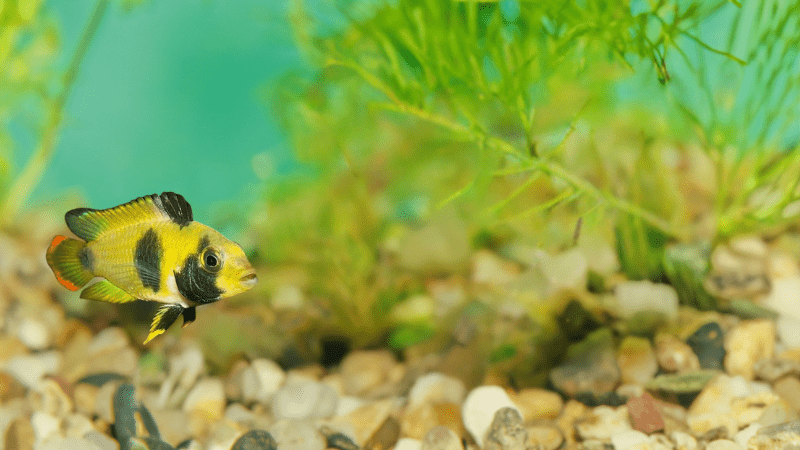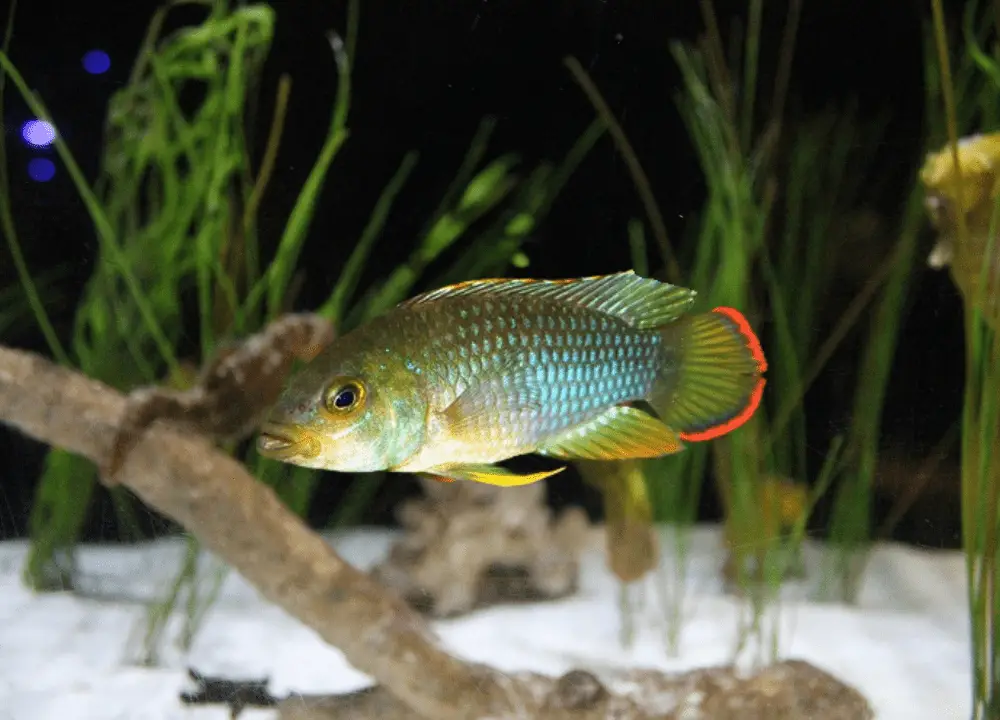The Apistogramma Nijsseni, commonly known as the Panda Dwarf Cichlid, is a small, visually striking freshwater fish. Originating from Peru’s Amazon River, it is prized among aquarists for its vibrant coloration and intricate behavior.
Dive into the world of the Apistogramma Nijsseni, a gem within the aquatic hobby. These diminutive yet dynamic fish captivate enthusiasts with their expressive personalities and ease of care. With a typical size of just 3 inches, they are perfect for smaller aquarium setups, creating a big impact in a compact space.
Their distinct black and white patterning, reminiscent of a panda bear, coupled with the males’ striking color display, makes them a popular choice for those seeking an eye-catching addition to their community tanks. As peaceful bottom-dwellers, Apistogramma Nijsseni thrive in well-planted tanks with plenty of hiding spots, soft water parameters, and a diet rich in variety, ensuring they display their best health and colors.
Table of Contents
Appearance Apistogramma Nijsseni
Exploring the vibrant world of Apistogramma Nijsseni, one can’t help but be captivated by their striking appearance. Known for their dynamic looks and engaging presence, these dwarf cichlids are a marvel in freshwater aquaria. Let’s dive into what makes the Apistogramma Nijsseni a true standout in terms of size, shape, and coloration.
Size And Shape
The Apistogramma Nijsseni, often referred to as the Panda Dwarf Cichlid, boasts a compact and rounded body. Its endearing size is a key attraction, making it perfect for smaller aquatic setups.
- Max Length: Typically reaches up to 3 inches (7.5 cm).
- Dimorphic Traits: Males are larger and portray more pointed fins.
- Shape: Displays a symmetrical, oval body with a pronounced dorsal fin.
Coloration
Flaunting an array of colors, Apistogramma Nijsseni are true underwater rainbows. Their coloration is not just beautiful but also quite unique among freshwater fish.
The males showcase a brilliant blue body with dark vertical stripes and hints of red or orange on the fins. In contrast, females often display a softer yellowish hue with a characteristic black abdominal spot, earning them the adorable nickname ‘Panda’.
Key Color Features – Apistogramma Nijsseni
| Male | Brilliant blue body Dark vertical stripes Red or orange fin accents |
| Female | Yellowish body Black abdominal spot |
Habitat
The Apistogramma Nijsseni, commonly known as the Panda Dwarf Cichlid, thrives in a unique underwater world. Let’s dive into the habitat of this vibrant aquatic creature.
Natural Habitat
In the wild, these colorful fish call the Peruvian Amazon their home. Shallow, slow-moving streams and lagoons, rich with dense vegetation, set the perfect stage for their existence.
Tank Requirements
Mimicking their natural environment in home aquariums is key for their health and happiness.
| Parameter | Requirement |
|---|---|
| Water Temperature | 73-86°F (23-30°C) |
| pH Level | 5.0-7.0 |
| Water Hardness | Soft |
| Tank Size | Minimum 20 gallons |
| Decoration | Driftwood, plants, caves |
Behavior
The Apistogramma Nijsseni, also known as the Panda Dwarf Cichlid, exhibits fascinating behaviors that charm aquarium enthusiasts. These small, yet mighty fish bring a dynamic aspect to home aquariums. Observing their daily interactions provides insights into their complex social structures and breeding rituals. Let’s dive into their specific behaviors below.

Social Interaction
Apistogramma Nijsseni are known for their vibrant social habits. In the wild, they inhabit densely planted areas of slow-moving waters, where they engage actively with their environment. In captivity, they adopt a similar social structure.
- Territorial: Males are especially territorial and need plenty of space.
- Community Friendly: These fish get along with other non-aggressive species.
- Hiding Spots: They appreciate hiding spaces such as caves and plants.
Creating areas for shelter in your aquarium can greatly improve their comfort and social interaction.
Breeding Behavior
Apistogramma Nijsseni have intriguing courtship and parental behaviors. They are monogamous by nature, often forming strong pair bonds.
| Stage | Behavior |
|---|---|
| Courtship | Male displays vivid colors and dances to attract a mate. |
| Spawning | Females lay eggs in a secure, hidden location. |
| Parental Care | Females guard the eggs, while males protect the territory. |
Understanding their breeding behavior helps keep their stress levels low and encourages successful spawning in an aquarium setting. It’s essential to mimic their natural habitat to promote these innate behaviors.
Diet Apistogramma Nijsseni
If you’ve got a colorful Apistogramma Nijsseni in your aquarium, it’s key to know about their diet. These little fish have big appetites and what you feed them matters a lot. A good diet keeps your fish happy, healthy, and vibrant.
Natural Diet
In the wild, Apistogramma Nijsseni are known to be picky eaters. They prefer live food such as insect larvae, small crustaceans and worms. Their natural diet helps them flourish and display bright colors.
Feeding In Captivity
Feeding your Apistogramma Nijsseni in an aquarium is a bit different. They do well on a mix of foods. Here’s what you can offer:
- Live foods: brine shrimp, bloodworms, and daphnia.
- Frozen options: to mix things up.
- High-quality flakes: for daily feeding.
- Pellets: as a staple diet.
Stick to regular feeding schedules and don’t overfeed. Your fish will thrive with the right diet balance.
Tankmates
Understanding the tankmates for your Apistogramma Nijsseni is essential. These small and colorful cichlids need peaceful friends. A harmonious tank means happy fish, all displaying their best colors and behaviors. Select companions carefully for a thriving aquarium community.
Compatibility With Other Fish
Fish compatibility often depends on temperament and size. Bold Apistogramma Nijsseni are peaceful, yet they can be territorial. They thrive with fish that don’t invade personal space or compete aggressively for food.
Choosing Suitable Tankmates
When selecting tankmates for Apistogramma Nijsseni, consider their peace-loving nature. Ideal companions should be gentle and similar in size.
- Dwarf Shrimp: They are peaceful and add vibrant color to the tank.
- Small Tetras: Their gentle demeanor makes them perfect tankmates.
- Snails: Useful for cleaning, they are unlikely to bother the cichlids.
- Corydoras: As bottom dwellers, they will not intrude on Apistogramma territory.
Ensure a mix that allows every fish to thrive, paying close attention to water parameters and the needs of each species.
| Tankmate Type | Compatibility | Comments |
|---|---|---|
| Aggressive Fish | Poor | They can stress or harm Apistogramma Nijsseni. |
| Large Fish | Poor | Potential predators to these small cichlids. |
| Peaceful Schooling Fish | Good | Provide company without causing stress. |
Care
Caring for Apistogramma Nijsseni is a fulfilling journey, teeming with vibrant life and rich aquatic vistas. Mastery in maintaining ideal water parameters and performing consistent tank maintenance remains key to a thriving habitat for these jewel-like fish. Embrace the allure of this delightful challenge, and watch as your aquarium becomes a bustling underwater paradise.
Water Parameters
Creating the perfect home for Apistogramma Nijsseni starts with quality water conditions. It’s the fabric of their existence, a critical tapestry weaved with precision. Abide by these guidelines to ensure your aquatic friends flourish:
| Parameter | Ideal Range |
|---|---|
| Temperature | 73-81°F (23-27°C) |
| pH Level | 4.0-6.0 |
| Water Hardness | 0-10 dGH |
Regular testing keeps your tank’s conditions ideal. Adjustments may be necessary to mimic their natural Amazonian waters. This hands-on approach promotes healthy growth and vitality in your Apistogramma Nijsseni.
Tank Maintenance
Consistency in tank upkeep guards against harmful toxins that could stress or harm your fish. Cross these tasks off your checklist to maintain a pristine environment:
- Weed out dead plants and debris; these can contaminate the water.
- Perform weekly water changes, approximately 25%, to keep toxins low.
- Clean filter media and other equipment regularly without disrupting beneficial bacteria.
- Monitor tank fittings and accessories for wear and tear.
Keep in mind, gentle care prevents stress for your Apistogramma Nijsseni. Stress can lead to health issues, so handle with care during any maintenance activity.
You will be interested to know everything TYPES OF APISTOGRAMMA
Breeding Apistogramma Nijsseni
Excitement fills the tank when Apistogramma Nijsseni begin their breeding dance. These colorful dwarf cichlids, also known as Panda Cichlids, offer an intriguing spectacle as they reproduce. Breeders and enthusiasts alike revel in the opportunity to observe and support the creation of new life within their aquatic habitats. Understanding the breeding process is key to raising healthy Apistogramma Nijsseni offspring.
Courtship And Pairing
Courtship in Apistogramma Nijsseni is an engaging affair. Males showcase vibrant colors to attract females. The males dance and show off their fins to impress potential mates. Once a female is charmed, she will follow the male to a chosen breeding site.
- Males display their brightest hues.
- They perform a distinctive dance.
- Pairing happens when a female accepts the male.
Breeding Conditions
To successfully breed Apistogramma Nijsseni, the tank environment must be just right. Warm, soft, slightly acidic water mimics their natural habitat. Providing caves or coconut shells creates ideal spawning locations. Stable water parameters and a nutritious diet ensure the fish are healthy for breeding.
| Condition | Requirement |
|---|---|
| Water Temperature | 78-80°F |
| pH Level | 5.0-7.0 |
| Water Hardness | Soft |
| Spawning Sites | Caves or Shelters |
- Keep water warm and soft.
- Maintain stable pH.
- Provide ample hiding spots.
- High-quality diet is a must.
Frequently Asked Questions Of Apistogramma Nijsseni
What Is The Apistogramma Nijsseni?
Apistogramma Nijsseni, commonly known as the Panda Dwarf Cichlid, is a freshwater fish native to Peru. It’s popular in the aquarium hobby for its striking colors and manageable size, growing up to 3 inches in length.
How To Care For Apistogramma Nijsseni?
Provide a tank of at least 20 gallons with soft, acidic water. They thrive in temperatures between 72°F and 86°F. Include plenty of hiding spots and a sandy substrate to mimic their natural habitat. They require a balanced diet of high-quality flakes, pellets, and live foods.
Apistogramma Nijsseni Breeding Tips?
To breed Apistogramma Nijsseni, condition them with live foods and ensure a female-friendly environment with caves for spawning. Optimal breeding occurs at slightly higher temperatures around 79°F. The female tends to the eggs, which hatch in 2-3 days.
What Do Apistogramma Nijsseni Eat?
In the wild, they feast on small invertebrates and zooplankton. In captivity, they should be fed a varied diet, including frozen or live brine shrimp, daphnia, and micro-worms. High-quality flakes or pellets are also suitable for their dietary needs.
Conclusion
Exploring the intricate wonders of the Apistogramma Nijsseni is truly rewarding for any aquarium enthusiast. Embracing their vivid colors and unique behavior adds diversity to any tank. Remember, consistent care ensures their vibrant presence thrives. Before introducing these dwarf cichlids, research is key.
Delight in their underwater dance for a captivating tank experience.


